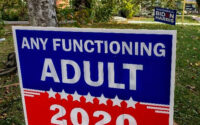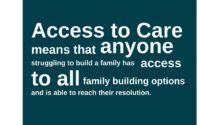Against Hillbilly Hot Takes: Humanizing Rural Appalachia through Nuanced Rhetorical Frames
In Spring of 2020, The New York Times published the article “Where Americans didn’t stay home even as the virus spread,” featuring infographics based on cell phone data. These graphics showed that during nationwide stay-at-home orders in the early days of COVID-19, travel patterns in urban areas fell below two miles, while patterns in rural areas in Appalachian and Southern regions of the United States remained normal. While the article itself did not explicitly say that rural communities weren’t heeding stay-at-home orders and were therefore spreading COVID-19, this position was taken up across social media almost immediately. Posts with phrases like “Rural America is still operating in ‘hoax’ mode” began to circulate, attributing increases in the spread of COVID-19 to the behavior of rural communities–ignoring the reality that traveling less than two miles a day is simply not possible in many rural communities.1
The material realities of rural communities are often muddied in larger narratives that over-simplify the dynamics of rural communities, especially in the Appalachian region. Stretching over 700,000 square miles and 13 states, Appalachia is often imagined through two opposing figures: “the romanticized mountaineer and the demonized hillbilly” (Kurlinkus and Kurlinkus 94). The region is often associated with central Appalachia, which contains parts of Kentucky, Ohio, North Carolina, Tennessee, Virginia, and all of West Virginia (“About”). One feature of this region is its natural resources, including coal, which has dominated many stories. In both 2016 and 2020 election cycles, news outlets regularly ran stories with headlines like “In the heart of Trump Country” (describing West Virginia) and “The place that wants Trump the most” (describing coal towns in southwestern Virginia). While most counties in Appalachia went red for Trump in both elections, causing some to attribute his victory to those areas, suburban voters in seven swing states (Florida, Georgia, Ohio, Pennsylvania, Michigan, Texas, and Wisconsin) “gave Donald Trump enough of a margin to beat Hillary Clinton” (Frey) in 2016.
These are just two examples that demonstrate how rural Appalachians are represented in national narratives. From the lore of the Hatfield-McCoy feud to unsettling scenes in Deliverance and jokes in “Appalachian Emergency Room” skits on Saturday Night Live in the mid-2000s, countless cultural vignettes paint rural Appalachians as ignorant, impulsive, and uneducated. J.D. Vance’s 2016 Hillbilly Elegy has been taken up with great velocity, reifying already-existing stereotypes in our cultural landscape with his claims that Appalachians are “immune to hard work” (9). As others have argued, boiling down the Appalachian region into a stereotype reifies unjust power dynamics (Hayes), obscures the presence of difference (Bradshaw), and creates inequitable spaces for students (Webb-Sunderhaus). However, negative attitudes toward Appalachia are embedded in America’s cultural consciousness, dating back to sensationalist journalism in the 1800s (Plein). These attitudes are conjured during times of political change and, I argue, dehumanize rural Appalachian communities. This dehumanization makes it easier for people in metropolitan areas to subscribe to stereotypes, sowing division between communities that would benefit from building coalitions together. “Appalachia” is a loaded word, and, as rhetoricians, we know how much one word can matter. And while it is important to confront the racial and social inequalities woven into the social fabric of Appalachia and the South2—as well as the rest of the U.S.—that contribute to narratives about these regions, it is just as important to amplify those who have been working tirelessly towards a better future in these places. There is, as Adichie claims, danger in a single story; all people, in all places, deserve to be viewed with nuance, with attention towards the many stories that make up a place.
The Power of Rhetorical Frames
We use rhetorical frames to understand the world and those around us. Frames encapsulate our approach (long-held beliefs, emotions, previous experiences, general knowledge, and so on) and shape how we identify with others and are therefore persuaded (or not) by their arguments (Burke). According to Lakoff, systems of frames are strengthened by language and make up entire ideologies: “…ideological language repeated often enough can become ‘normal language’ but still activate that ideology unconsciously” (72). When we hear the same lines repeatedly (“Trump Country” for example), our preconceived notions are strengthened.
As a result, the frames that we take up in discussing communities determine not only how we perceive those communities but how we treat them. Shah agrees with Lakoff that frames “can be intentionally built through repetition in words and experiences” and further argues that they “can have concrete consequences on . . . power dynamics, ethics, and outcomes” (87). Frames that shame Appalachian communities produce what Asen calls “indirect exclusions,” which “function tacitly through discursive norms and practices that prescribe particular ways of interacting in public forums” and “effectively negate the perspectives and contributions” of excluded communities (345). Though Appalachians are not directly barred from participating in public conversation, they must grapple with stereotypes rooted deeply in particular ideologies that mark them as “other,” making it difficult for them to gain credibility with audiences that might view them primarily as stereotypes. As Asen argues, “participation in public discussions does not proceed only through voice and body; inclusions and exclusions also occur in the perceptions of others—the imagining of others” (347). This imagining, in Appalachia’s case, is often dehumanizing, undermining the humanity of Appalachian people and strengthening division between the region and the rest of the country.
Expanding the Appalachian Frame
“Appalachian” operates as a god term, or a word that represents a network of meanings rooted in a larger cultural context. Kurlinkus and Kurlinkus argue that god terms, despite their shared connotations, are also open for interpretation: “By way of their non-specificity, god terms also hold the power to unify a manifold audience, for each member performs an act of closure, positing his own sense of the term” (52). God terms are simultaneously flexible and fixed, inviting audiences to interpret the term in ways that resonate with them. Appalachian communities are often seen as either bastions of bygone days with outdated ideas that squash progress, or as an idealistic haven of traditional values. Williams writes that rural Appalachia is seen as “both the essence of America and a place apart” (8). This duality puts rural communities into a strange space that allows them to be used as scapegoats in political arguments (i.e., “Trump Country” coverage) because they are presented with absolutely no nuance. Below, I share three common dehumanizing assumptions rooted in the use of Appalachia as a god term and explain how those assumptions perpetuate simplistic and problematic representations of rural people.
Rural Appalachia Is Often Seen as a Site for Extracting Natural Resources
Only one-fourth of the counties in the Appalachian region are classified as rural (“About”), but these counties hold a wealth of natural resources. According to the U.S. Department of Energy, Pennsylvania and West Virginia are two of the top five energy-producing states in the nation with their stores of coal and natural gas; North Carolina, Virginia, and West Virginia are three of the top lumber-producing states in the nation (Center for Sustainable Biomaterials & Bioenergy). The sparsely populated landscape contributes to an association of rural Appalachia with natural resources, often overshadowing the people that live in those areas. For most of the country, Appalachia is immediately represented by the electricity used to power their homes, or timber used to construct those homes–important resources, but resources devoid of a human presence.
This separation obscures the material realities facing rural communities in terms of accessing the resources that they produce. For example, West Virginia has seen a fourfold increase in natural gas production and distribution in the past decade; however, most natural gas extracted from West Virginia does not go to West Virginia residents. Instead, it goes to out-of-state or even international markets (“West Virginia”). Similarly, despite our general associations of rural land with food production, many rural residents struggle to access fresh food. In one eastern Ohio county, a survey reported that nearly half of households were food insecure–three times the national average for households with children (Holben et al. 239); across 10 four-year institutions in Appalachia, 30.5% of college students reported being food insecure when the national average is approximately 12% (Hagedorn, et al. 6). These disparities present a very different reality for rural communities than what one might assume (i.e., vast natural resources at one’s fingertips). These disparities also point towards the extraction of wealth from rural communities that is not reciprocated–disparities that are not obvious when we adopt frames that cast rural areas as resource-rich treasure troves for the rest of the country and, by extension, erase the people that live in those areas.
Rural Appalachia Is Typically Imagined as Homogenous in Terms of Identity
Images shared of rural residents are normally homogenous, depicting rural community members as white, heterosexual, cis-gender, older, Christian, and, often, politically conservative–especially in Appalachia. In fact, representations of rural life in Appalachia tend to highlight white poverty. In the 1960s, photographer John Dominis traveled throughout central Appalachia, an area that reported a poverty rate of 59.4% in 1960 (Moore, n.p.). Dominis’ pictures appeared in Life magazine and in materials that circulated surrounding President Lyndon B. Johnson’s “War on Poverty”’ that was announced in central Appalachia. More recent depictions of rural life in these regions also focus on whiteness, including the aforementioned Hillbilly Elegy and productions like the 2009 documentary The Wild and Wonderful Whites of West Virginia and the popular early-2000s MTV show Buckwild.
This monolithic imagining, however, is not accurate. Among other counternarratives, Catte challenges the synonymy of rurality with whiteness (64); Reddy notes the history of native American tribes in rural areas (82); Spriggs and Paden amplify the stories of black Appalachians, including Affrilachian artists (18); and Nichols laments the erasure of rural LGBTQ people in dominant narratives (n.p.). While demographically, yes, Appalachia is predominately white, an acceptance of whiteness as the default in these rural areas bolsters what Lorde calls a “mythical norm” (116). Smith notes the frequency with which whiteness is accepted as the norm in Appalachia by focusing on class and region (Smith 43), despite the presence of diversity in the region. Coal communities in Kentucky, Tennessee, and West Virginia were quite diverse in the early 20th century, with entire communities of Black coal miners settling, including in Benham County, Kentucky (Brown). Latinx immigrants have increasingly moved to rural communities across the nation, including in Appalachia and the South; since 1990, the Latinx population in rural areas has more than doubled (Turner). Frames that pass over the diversity that is present in rural Appalachia causes harm, as it erases marginalized groups from public narratives, making it more difficult for them to share their experiences while simultaneously perpetuating a simplistic and inaccurate frame of reference for the region.
Rural Appalachians Are Commonly Represented through Stereotypes that Undermine Them
Fallacious thinking in regard to resources and identity lead to widespread stereotyping of Appalachians, including the idea that Appalachia is unanimously united for conservative, even far-right leaning candidates (despite the region’s long history of voting for pro-labor candidates). In recent presidential elections, Appalachian counties (especially rural ones) have gone red (Wright). Given that Republican-backed policies often favor limited social programs (“Beyond”) that would benefit vulnerable people experiencing poverty, racial injustice, and other hardships, comments that Appalachians “vote against their own interests” are commonplace. Ferrari and Rhee push back against the notion that “entire parts of the nation like Appalachia act or vote against their own self-interest,” arguing that making “sweeping inferences” is “literally the dictionary definition of discrimination” (850-851). They argue that, instead, our focus should be on how people in Appalachia have “prospered or perished” under political leaders (851)–redirecting our focus away from everyday people and towards institutional power. Vast generalizations further divide us and ignore the long history of corporate extraction and exploitation that has shaped Appalachian communities (see Catte; Eller).
In fact, because of this history, Appalachia has a rich tradition of progressive labor politics and community organizing that gets overlooked. The Battle of Blair Mountain, the largest labor uprising in US history, took place in West Virginia in 1921, when a coalition of Black, white, and immigrant coal miners fought for better working conditions (Shogan); teacher’s strikes in Kentucky (2019) and West Virginia (2016) resulted in higher wages and benefits for teachers as well as increased attention on educational policy (Will); and East Tennessee is home to the Highlander Research and Education Center, an organization dedicated to social justice in Appalachia and the South that hosted both Martin Luther King, Jr. and Rosa Parks during the Civil Rights Movement (“About Us”). The list goes on and on. Opting for narratives that fail to acknowledge the progressive work that has happened and continues to happen in Appalachia does a disservice to the people doing that work while living in conditions that are, admittedly, often less than ideal. Further, when Appalachians see themselves portrayed in a negative light, they can adopt “a kind of political depressiveness, a blockage in activity and optimism, a disintegration of politics toward isolation, frustration, anomie, forgetfulness” (Warner 70), furthering the gap between them and their counterparts in other areas of the country that face similar problems. Appalachian people deserve a different frame–one that views them and their places with nuance.
Conclusion: Framing Has Its Place
The associations we have with place–rural, urban, and somewhere in between–directly shape how we feel about the world and, as a result, how we treat others. The way we talk about a place has material effects on the people that inhabit that place. To avoid dehumanizing rural people, we must try to identify with rural life and rural people (Donehower et al. 9). And place is complicated–it is an important identity marker, but it is not the only identity marker. Theories of intersectionality (Crenshaw), emerging from the experiences of black women, illuminate the layered and dynamic nature of identity, where place–among other factors including race, class, sexuality, gender identity, age, citizenship, disability, and ethnicity–all interact with one another.
Place is not a static container for meaning–it is always changing, always moving (Powell, 15). Our rhetorical frames have the capacity to change and move as well. Carlo argues that we are consistently “revising” place as a form of “imaginative labor” (61) and calls for us to “participate in this change through our advocacy…in order to better our social realities” (68). Framing is in many ways an automatic process, but we must intentionally develop frames that acknowledge nuance in order to better understand people and their places. By disregarding an entire region based on dehumanizing representations, we 1) abandon rural residents who do not subscribe to those beliefs or ways of being, 2) reify stereotypes that perpetuate material inequalities that disproportionately impact already-vulnerable groups, and 3) strengthen the divisions between rural and urban communities that face many of the same challenges and would benefit from more opportunities to view one another clearly. A nuanced frame doesn’t ignore or rationalize problems–it places them in context so that we can more fully understand how we might confront those problems.
Simply put, place matters, and so do the frames that we use to talk about place. Our frames should empower and engage, not scapegoat, or simplify, people in all places.
Endnotes
- As of May 2019, 3.11 miles was the median distance to the nearest grocery store in rural areas (Simpson n.p.). return
- Appalachia and the South often find themselves represented in similar ways in the media, and given the span of the Appalachian region (from northern Alabama and Georgia up to New York), some areas are categorized as belonging to both regions. return
Works Cited
“About the Appalachian Region,” Appalachian Regional Commission, https://www.arc.gov/about-the-appalachian-region/. Accessed 20 Dec. 2022.
“About Us.” Highlander Research and Education Center, https://highlandercenter.org/about-us/, Accessed 20 Dec. 2022.
Adichie, Chiamanda Ngozi. “The Danger of a Single Story,” 2009, TEDGlobal. https://www.ted.com/talks/chimamanda_ngozi_adichie_the_danger_of_a_single_story
Asen, Robert. “Imagining in the Public Sphere.” Philosophy and Rhetoric, vol. 35, no. 4, 2002, pp. 345-67.
“Beyond Red vs. Blue: The Political Typology,” Pew Research Center, 09 Nov 2021, https://www.pewresearch.org/politics/2021/11/09/the-republican-coalition/
Bradshaw, Jonathan L. “Keeping With: The Civic Work of Heritage Frames.” Rhetoric Review vol. 38, no. 2, 2019, pp. 190-204.
Brown, Karida L. Gone Home: Race and Roots through Appalachia. UNC P Books, 2018.
Burke, Kenneth. A Rhetoric of Motives. U of California P, 1969.
Carlo, Rosanne. “Keyword Essay: Place-Based Literacies.” Community Literacy Journal, vol. 10, no. 2, 2016, pp. 59–70.
Catte, Elizabeth. What You Are Getting Wrong with Appalachia. Belt Publishing, 2018.
Center for Sustainable Biomaterials & Bioenergy. “Hardwood Product Trade.” University of West Virginia, 2022, https://bioenergy.wvu.edu/complete-projects/hardwood-trade/wv-wood-trade-market.
Crenshaw, Kimberlé W. On Intersectionality: Essential Writings. The New Press, 2017.
Daniel, James Rushing. “Everybody Will be Hip and Rich: Neoliberal Discourse in Silicon Valley.” Present Tense, vol. 6, no. 2, 2017, http://www.presenttensejournal.org/volume-6/everybody-will-be-hip-and-rich/.
Department of Energy. “How Much Energy Does Your State Produce?,” Energy.gov, 10 Nov. 2014, https://www.energy.gov/articles/how-much-energy-does-your-state-produce#:~:text=Immediately%2C%20you%20will%20notice%20that,five%20fossil%20energy%2Dproducing%20states.
Donehower, Kim, et al. “Introduction.” Reclaiming the Rural: Essays on Literacy, Rhetoric, and Pedagogy, edited by Kim Donehower, Charlotte Hogg, and Eileen Schell, Southern Illinois University Press, 2011, 1-16.
Eller, Ronald. Uneven Ground: Appalachia Since 1945. UP of Kentucky, 2013.
Ferrari, Aaron, and Will Rhee. “Unified in Dignified Appalachian Pride.” West Virginia Law Review, vol. 120, no.3, 2018, p. 8.
Frey, William. “Biden’s Victory Came from the Suburbs.” Brookings, 13 Nov. 2020, https://www.brookings.edu/research/bidens-victory-came-from-the-suburbs/
Hayes, Amanda E. The Politics of Appalachian Rhetoric. West Virginia UP, 2018.
Holben, David H., et al. “Food Security Status of Households in Appalachian Ohio with Children in Head Start.” Journal of the American Dietetic Association, vol. 104, no.2, 2004, pp. 238-41.
Kurlinkus, Will, and Krista Kurlinkus. “Coal Keeps the Lights On.” College English, vol. 81, no.2, 2018, pp. 87-109.
Lakoff, George. “Why It Matters How We Frame the Environment.” Environmental Communication, vol. 4, no. 1, 2010, pp. 70-81.
Lorde, Audre. “Age, Race, Class, and Sex: Women Redefining Difference,” 1984. In Let Nobody Turn Us Around: Voices of Resistance, Reform, and Renewal; An African American Anthology, edited by Manning Marable and Leith Mullings, pp. 538-44. New York: Bowman & Littlefield Publishers, Inc., 2000.
Moore, Molly. “Appalachia’s Place in the War on Poverty.” The Appalachian Voice, 09 Apr 2014, https://appvoices.org/2014/04/09/appalachias-place-in-the-war-on-poverty/.
Olfert, Melissa D., et al. “Struggling with the Basics: Food and Housing Insecurity Among College Students Across Twenty-Two Colleges and Universities.” Journal of American College Health, 2021, pp. 1-12. doi: 10.1080/07448481.2021.1978456
Plein, Stewart. “Portraits of Appalachia: The Identification of Stereotype in Publishers’ Bookbindings, 1850-1915,” Journal of Appalachian Studies, vol. 15, 2009, pp. 1-2.
Powell, Douglas Reichert. Critical regionalism: Connecting politics and culture in the American landscape. UNC P Books, 2012.
Reddy, Nancy. “‘The Spirit of our Rural Countryside’: Toward an Extracurricular Pedagogy of Place.” Community Literacy Journal, vol. 13, no. 2, 2019, pp. 69-87.
Shah, Rachael W. “‘What Is It That’s Going on Here?’: Community Partner Frames for Engagement.” Community Literacy Journal, vol 14, no. 2, 2020, pp. 72-92.
Shogan, Robert. The Battle of Blair Mountain: The Story of America’s Largest Labor Uprising. Basic Books, 2006.
Simpson, April. “As Rural Groceries Fade Away, Lawmakers Wonder Whether to Act.” Pew Stateline, 02 Oct. 2019, https://www.pewtrusts.org/en/research-and-analysis/blogs/stateline/2019/10/02/as-rural-groceries-fade-away-lawmakers-wonder-whether-to-act#:~:text=The%20median%20distance%20to%20the,of%20Agriculture%2C%20which%20oversees%20the
Smith, Barbara Ellen. “De-gradations of Whiteness: Appalachia and the Complexities of Race.” Journal of Appalachian Studies, vol. 10, no. 1/2, 2004, pp. 38-57.
Spriggs, Bianca Lynne, and Jeremy Paden. “Introduction.” Black Bone, edited by Bianca Lynne Spriggs, Jeremy Paden, and Frank X Walker, UP of Kentucky, 2018, pp. 17-19.
Turner, Kimberly, et al. “The Changing Geography of Hispanic Children and Families.” National Research Center on Hispanic Children and Families, vol. 6, 2016, pp. 1-9.
“West Virginia Natural Gas Production,” U.S. Energy Information Administration, https://www.eia.gov/dnav/ng/hist/na1160_swv_2a.htm. Accessed 20 Dec. 2022.
Vance, J.D. Hillbilly Elegy: A Memoir of a Culture in Crisis. Harper Press, 2016.
Warner, Michael. Publics and Counterpublics. Zone Books, 2002.
Webb-Sunderhaus, Sara. “‘Keep the Appalachian, Drop the Redneck’: Tellable Student Narratives of Appalachian Identity.” College English, vol. 79, no. 1, 2016, pp. 11–33.
Will, Madeline. “When Teachers Strike, Education Becomes More Prevalent in Political Campaigns, Study Finds.” Education Week, 27 Oct. 2021, https://www.edweek.org/teaching-learning/when-teachers-strike-education-becomes-more-prevalent-in-political-campaigns-study-finds/2021/10.
Williams, John Alexander. Appalachia: A History. U of North Carolina P, 2003.
Wright, Jesse. “Explore How Appalachia Voted in 2020.” 100 Days in Appalachia, 02 Dec. 2020. https://www.100daysinappalachia.com/2020/12/explore-how-appalachia-voted-in-2020/.
COVER IMAGE CREDIT: Photograph by author
KEYWORDS: rural, stereotype, frame, public sphere, appalachia




 Dr. Erin Brock Carlson is an assistant professor in the Department of English at West Virginia University, where she teaches undergraduate and graduate courses in the Professional Writing and Editing program. Her current research addresses community organizing, place-based development, and collaborative knowledge making through participatory visual methodologies. Erin’s work has appeared in Technical Communication Quarterly, Journal of Business and Technical Communication, and Computers and Composition, among others.
Dr. Erin Brock Carlson is an assistant professor in the Department of English at West Virginia University, where she teaches undergraduate and graduate courses in the Professional Writing and Editing program. Her current research addresses community organizing, place-based development, and collaborative knowledge making through participatory visual methodologies. Erin’s work has appeared in Technical Communication Quarterly, Journal of Business and Technical Communication, and Computers and Composition, among others.